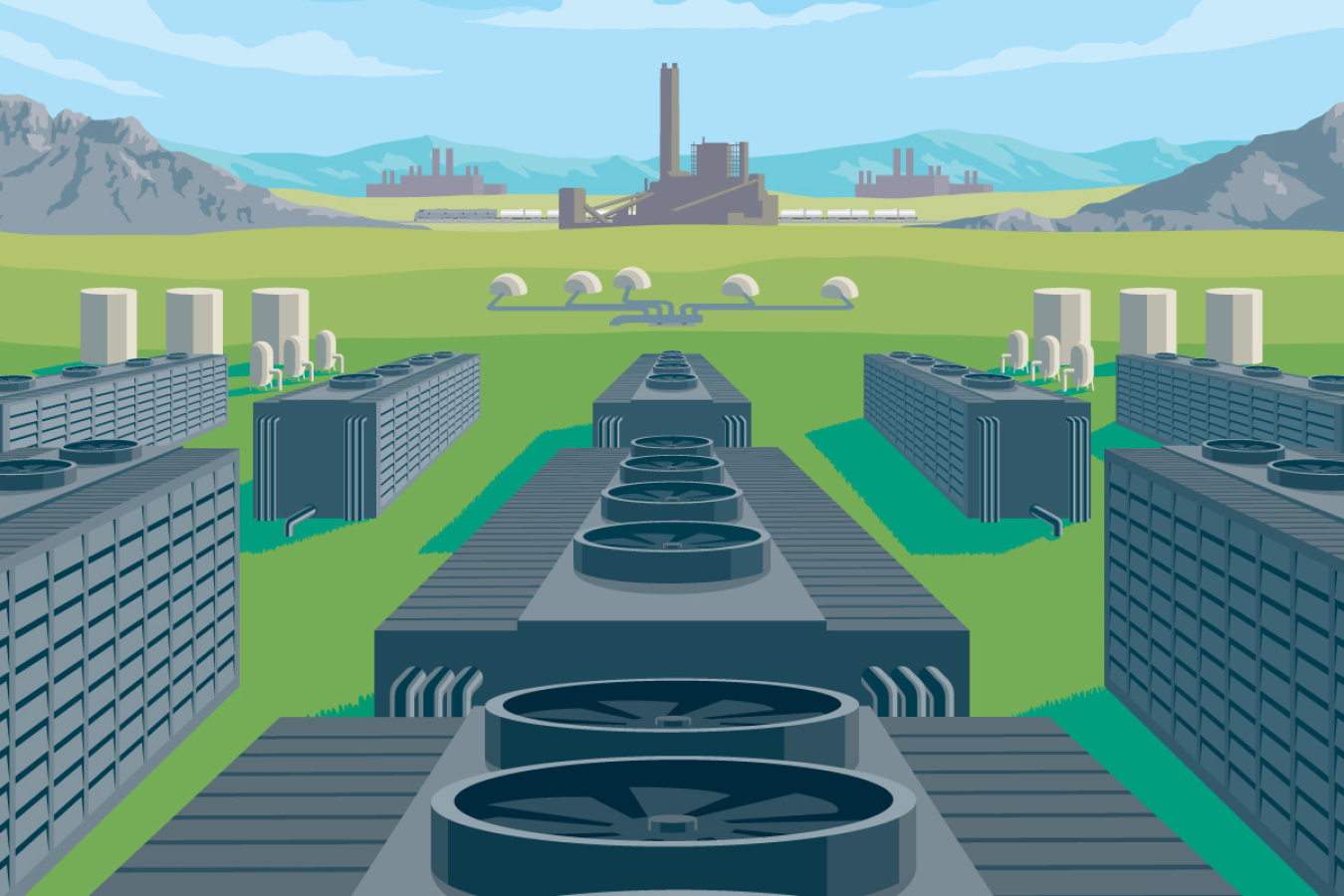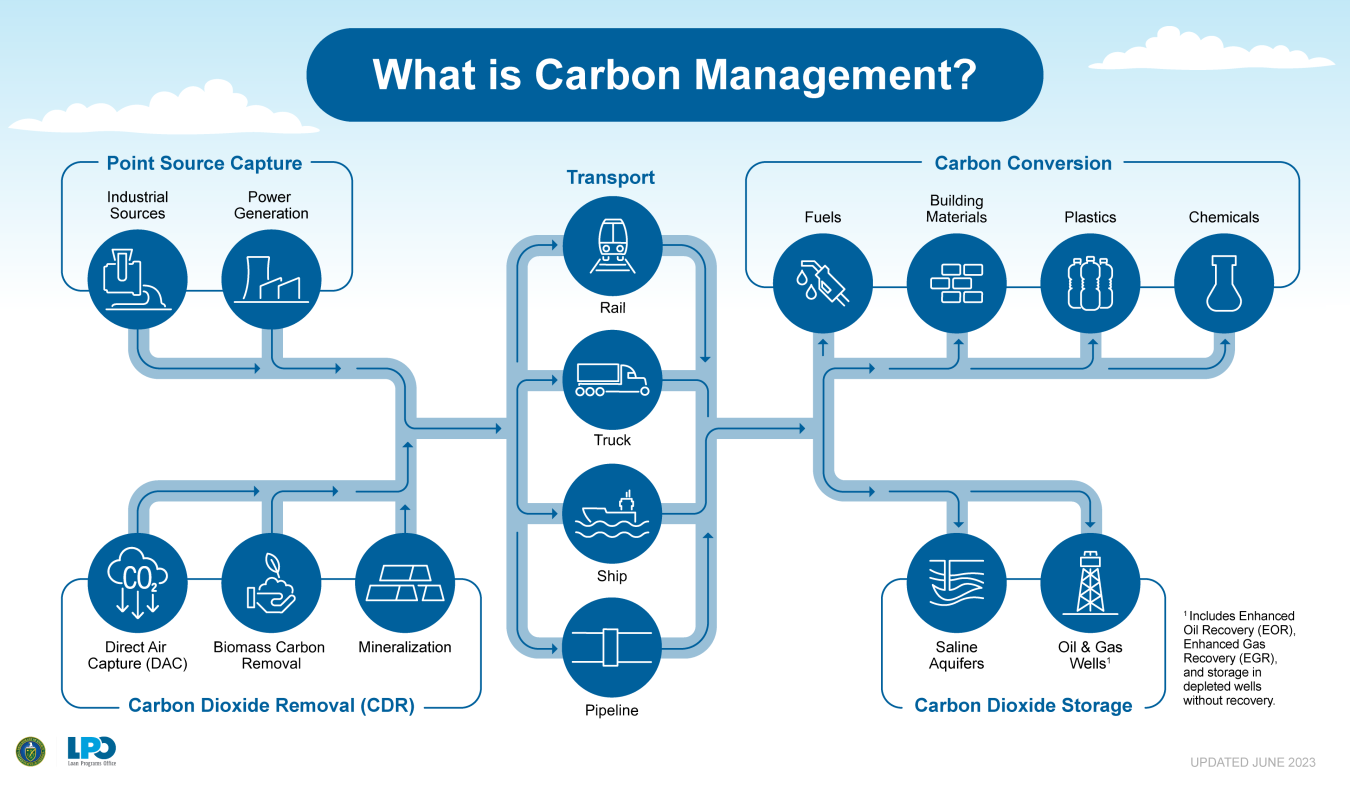
Containing Carbon: LPO investments in carbon management projects help avoid and remove emissions.
The U.S. Department of Energy’s (DOE’s) Loan Programs Office (LPO) is working to support the deployment of carbon management technologies to help the U.S. achieve net-zero greenhouse gas emissions by 2050. Accelerated by tens of billions of dollars in funding from recent legislation, DOE’s Carbon Negative Shot initiative, and decarbonization goals across the public and private sectors, carbon management technologies and infrastructure will play a key role in the shift to a net-zero economy.
LPO can support projects across the carbon management value chain, including point-source carbon capture, transport, utilization, and storage, and atmospheric carbon dioxide removal.
What is Carbon Management?
To achieve the Biden Administration’s climate goal of a net-zero economy by 2050, the United States will need to deploy an array of carbon management technologies and infrastructure to remove and store carbon dioxide emissions.
There are two general approaches to minimizing atmospheric carbon dioxide. Point-source carbon capture traps emissions at the site of production, preventing release into the atmosphere. Carbon dioxide removal (CDR), on the other hand, pulls out carbon dioxide that is already in the atmosphere. CDR can account for unavoidable emissions, such as those in difficult-to-decarbonize sectors without clear paths to point-source carbon capture and can address general emissions overshoot. Captured or removed carbon dioxide can be injected into geologic formations for permanent storage or converted into value-added products. In some cases, atmospheric carbon dioxide may be removed via mineralization or biomass.

What is the State of the Carbon Management Market in the US?
Depending on relative deployment of other technologies, achieving a net zero economy by 2050 will require capturing and storing 400 to 1,800 million tonnes of carbon dioxide annually by 2050, according to DOE’s recently published Carbon Management Liftoff Report. At about 25 million tonnes per year, current carbon capture, utilization, and storage in the U.S. is between one and five percent of those levels.
Still, the U.S. is already a global leader in carbon management, and the nation’s policy and geology are favorable for further deployment of carbon management technology. The Bipartisan Infrastructure Law provided about $12 billion in new carbon management funding for a five-year period, largely for direct air capture and carbon dioxide capture, transport, and storage. In addition, the enhancements to the 45Q federal tax credit in the Inflation Reduction Act have meaningfully improved project incentives, making carbon management projects economically feasible in several sectors. The U.S. has abundant natural geology suitable for storing captured or removed carbon dioxide.
Dozens of commercial carbon management projects are in operation globally today, and more than a hundred others are in project development. The Carbon Management Liftoff Report found that carbon management projects in industries with high-purity carbon dioxide streams, such as ethanol and hydrogen production and natural gas manufacturing, have the best project economics today.
Unlocking investments across other industries will require cost or revenue improvements, the build-out of shared transport and storage infrastructure to support projects, or policies and regulations that further drive deployment. LPO can finance early commercial deployments of carbon management technology, demonstrating to a range of investors that these technologies are bankable and ready for widespread adoption, accelerating commercial deployments, and reducing cost uncertainty.
Types of Projects LPO Can Finance
LPO can also finance development of common-use transport and storage infrastructure. According to the DOE Liftoff Report, meeting net-zero goals will require between 30,000 and 96,000 miles of carbon dioxide pipeline, a significant scale-up from the 5,000 miles currently in place. LPO’s Carbon Dioxide Transportation Infrastructure Finance and Innovation financing program, created through the Bipartisan Infrastructure Law, has funding specifically for development of common-carrier transportation infrastructure to facilitate a coordinated buildout of that infrastructure.
LPO can finance projects across the carbon management supply chain, which may include, but are not limited to:
- Point-source carbon capture: Projects that retrofit emissions-producing facilities with carbon capture equipment, including those related to natural gas processing, ammonia, cement, ethanol, hydrogen, iron and steel, and pulp and paper production, and coal and natural gas power generation
- Carbon dioxide removal: Projects that remove carbon dioxide from ambient air through direct air capture, biological approaches, and mineralization
- Carbon dioxide transport: Including compression facilities, pipelines, rail, shipping, and other transport methods
- Carbon dioxide storage: Facilities for safely and permanently storing captured carbon dioxide
- Carbon dioxide utilization (also called carbon conversion): Projects that utilize captured carbon dioxide in building materials, plastics, synfuels, or other useful products that deliver environmental benefits

